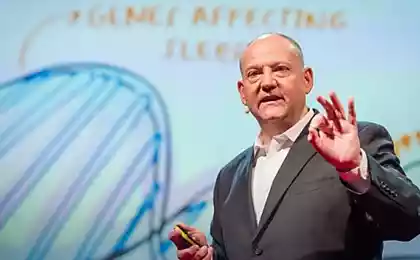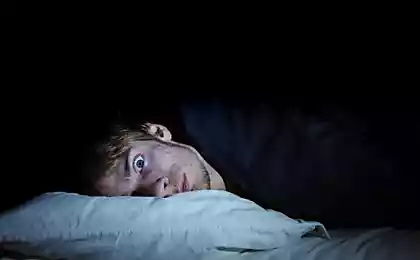737
How the brain decides when we sleep and when to Wake up
How the brain decides when we sleep and when to Wake up and do daily chores? Who is this mysterious watchmaker, daily transforming our internal clocks in the different States?
Finally managed to get the answer to these questions. Scientists of the School of medicine of the University of Maryland (University of Maryland School of Medicine UM SOM) has identified as the key path for fasulo transition between sleep and wakefulness. He, apparently, plays a major role in the adjustment "switch". The study, published in Nature Communications, is the first to explain this process in as detailed biophysical detail.
The opening subsequently can lead (and will lead) to more effective treatments for insomnia and the effects of jet lag.

Sleep and wakefulness - these are the main two States in which alternately the man dwells all his life. But millions of people have trouble with transitions between them - they are hard to fall asleep or to sleep at night without waking up, and then it is extremely difficult to stay awake during the day. Despite decades of research on how these transitions work, the internal mechanisms of circadian rhythm remain largely a mystery to neuroscientists. But recently there was a study, through which situation finally to change.
Andrea Meredith (Meredith Andrea), associate Professor, Department of physiology UM SOM, has focused his attention on a certain area of the brain - suprachiasmatic nuclei of the hypothalamus. This region acts as an internal clock, determining when we go to sleep how long, the body needs sleep and when it comes time to Wake up. In suprachiasmatic core specialists abbreviated as SHA, the researcher focused on ion channels that conduct electric current, passing information from one neuron to another. Thus, there was a group of structures known as BK-channels (Big K-channels, a family of potassium channel proteins), which were most active in SHA.
Dr. Meredith conducted research on mice whose schedule is completely opposite of the human they sleep during the day and awake at night. She found that VK-channels active during waking hours, which for mice accounted for the night time; during the day they didn't work.
The research team studied both normal mice and genetically modified so that the activity of BK-channels are suppressed. The researchers then recorded through electrodes placed in the neurons SHE. In the brain of genetically modified animals, where the channels are not subjected to inactivation, it was observed a lower level of neuronal activity, and this was associated with prolonged daytime wakefulness. And for mice, as you remember, it is unusual.
The new results somewhat surprising for several reasons. Researchers previously knew that any physiological process in the body, which relies on the inactivation of BK-channels, can be perceived as a mechanism. Scientists have known how the function of these channels, but did not understand exactly how neurons use this mechanism in order to adjust the encoding information in the brain. This is the first study which clearly demonstrated that the discovered process determines the circadian rhythm.

Mice sleep during the day, and BK-channels are inhibited. Their daily inactivation determines the high activity of neurons SHA that causes mice to fall asleep. Night VK-channels become active, starting the current of potassium ions (K+) that reduces neuronal activity. And this, in turn, leads to the fact that the mouse wakes up and, for example, run on a wheel. This relationship between neuronal activity and cycles of sleep/wakefulness resembles the one in humans, the only change is the opposite. Concept: Andrea Meredith.
Earlier experts already knew VK-channels as a regulator of other physiological functions. They are important for the activation of the muscles and play an important role in the control of blood pressure, heart rate and bladder functions. Brain functions of these channels was in the regulation of neuronal excitability and in the control of movement, learning and memory. Therefore, if the channels "fail", clinically it is manifested in the form tremor, seizures, development of dependence on something, and problems with learning and memory.
"We knew that the VC channels are crucial for many functions. But now we have convincing evidence that they are also specifically regulate the cycle of sleep-wakefulness. It's very interesting! "- said Professor Meredith.
Earlier was considered, that the change of "day/night" is largely due to a different mechanism - number of ion channels, which are located on the surface of neurons SHA. But it turned out that this model is too simplified: the main role plays the number of channels and the fact that they aktiviziruyutsya and "stop" at certain times of the day.
Also interesting: Healthy sleep — 4 tips from astronauts
Ivan Pigarev: "Sleep is not a waste of time, and medicine"
This finding has important clinical significance. Professor Meredith drew attention to the fact that the new understanding of the mechanism of inactivation can potentially be used in the development of medicinal products intended for the correction of circadian rhythms. This drug will be able to correct sleep problems, to treat the syndrome of jet lag, seasonal affective disorder, and any other pathology associated with the disruption of SHA.published
P. S. And remember, only by changing their consumption — together we change the world! ©
Join us in Facebook , Vkontakte, Odnoklassniki
Source: ai-news.ru/2016/04/povelitelem_sna_okazalsya_ionnyj_kanal_549330.html
Finally managed to get the answer to these questions. Scientists of the School of medicine of the University of Maryland (University of Maryland School of Medicine UM SOM) has identified as the key path for fasulo transition between sleep and wakefulness. He, apparently, plays a major role in the adjustment "switch". The study, published in Nature Communications, is the first to explain this process in as detailed biophysical detail.
The opening subsequently can lead (and will lead) to more effective treatments for insomnia and the effects of jet lag.

Sleep and wakefulness - these are the main two States in which alternately the man dwells all his life. But millions of people have trouble with transitions between them - they are hard to fall asleep or to sleep at night without waking up, and then it is extremely difficult to stay awake during the day. Despite decades of research on how these transitions work, the internal mechanisms of circadian rhythm remain largely a mystery to neuroscientists. But recently there was a study, through which situation finally to change.
Andrea Meredith (Meredith Andrea), associate Professor, Department of physiology UM SOM, has focused his attention on a certain area of the brain - suprachiasmatic nuclei of the hypothalamus. This region acts as an internal clock, determining when we go to sleep how long, the body needs sleep and when it comes time to Wake up. In suprachiasmatic core specialists abbreviated as SHA, the researcher focused on ion channels that conduct electric current, passing information from one neuron to another. Thus, there was a group of structures known as BK-channels (Big K-channels, a family of potassium channel proteins), which were most active in SHA.
Dr. Meredith conducted research on mice whose schedule is completely opposite of the human they sleep during the day and awake at night. She found that VK-channels active during waking hours, which for mice accounted for the night time; during the day they didn't work.
The research team studied both normal mice and genetically modified so that the activity of BK-channels are suppressed. The researchers then recorded through electrodes placed in the neurons SHE. In the brain of genetically modified animals, where the channels are not subjected to inactivation, it was observed a lower level of neuronal activity, and this was associated with prolonged daytime wakefulness. And for mice, as you remember, it is unusual.
The new results somewhat surprising for several reasons. Researchers previously knew that any physiological process in the body, which relies on the inactivation of BK-channels, can be perceived as a mechanism. Scientists have known how the function of these channels, but did not understand exactly how neurons use this mechanism in order to adjust the encoding information in the brain. This is the first study which clearly demonstrated that the discovered process determines the circadian rhythm.

Mice sleep during the day, and BK-channels are inhibited. Their daily inactivation determines the high activity of neurons SHA that causes mice to fall asleep. Night VK-channels become active, starting the current of potassium ions (K+) that reduces neuronal activity. And this, in turn, leads to the fact that the mouse wakes up and, for example, run on a wheel. This relationship between neuronal activity and cycles of sleep/wakefulness resembles the one in humans, the only change is the opposite. Concept: Andrea Meredith.
Earlier experts already knew VK-channels as a regulator of other physiological functions. They are important for the activation of the muscles and play an important role in the control of blood pressure, heart rate and bladder functions. Brain functions of these channels was in the regulation of neuronal excitability and in the control of movement, learning and memory. Therefore, if the channels "fail", clinically it is manifested in the form tremor, seizures, development of dependence on something, and problems with learning and memory.
"We knew that the VC channels are crucial for many functions. But now we have convincing evidence that they are also specifically regulate the cycle of sleep-wakefulness. It's very interesting! "- said Professor Meredith.
Earlier was considered, that the change of "day/night" is largely due to a different mechanism - number of ion channels, which are located on the surface of neurons SHA. But it turned out that this model is too simplified: the main role plays the number of channels and the fact that they aktiviziruyutsya and "stop" at certain times of the day.
Also interesting: Healthy sleep — 4 tips from astronauts
Ivan Pigarev: "Sleep is not a waste of time, and medicine"
This finding has important clinical significance. Professor Meredith drew attention to the fact that the new understanding of the mechanism of inactivation can potentially be used in the development of medicinal products intended for the correction of circadian rhythms. This drug will be able to correct sleep problems, to treat the syndrome of jet lag, seasonal affective disorder, and any other pathology associated with the disruption of SHA.published
P. S. And remember, only by changing their consumption — together we change the world! ©
Join us in Facebook , Vkontakte, Odnoklassniki
Source: ai-news.ru/2016/04/povelitelem_sna_okazalsya_ionnyj_kanal_549330.html























